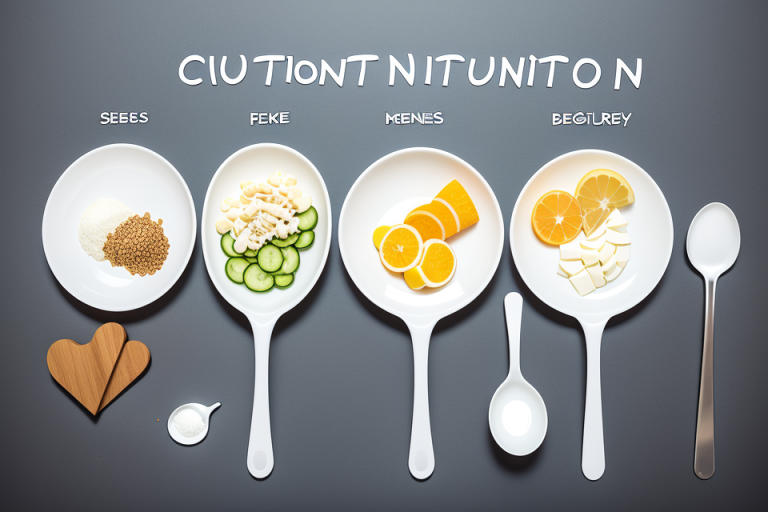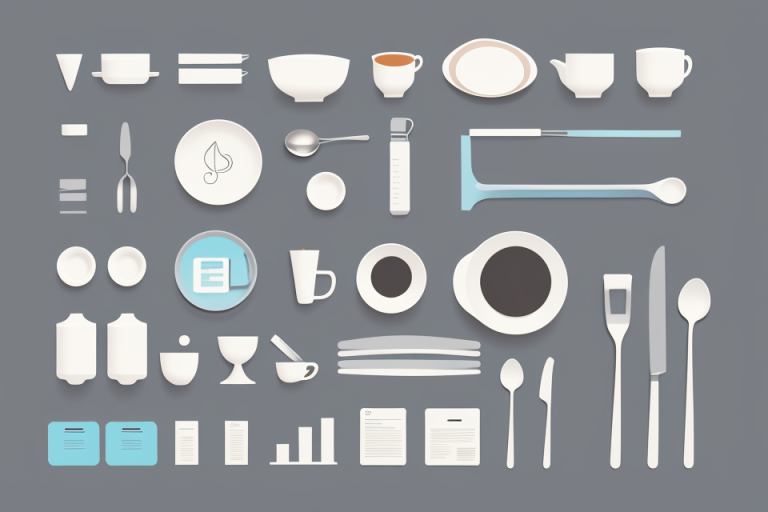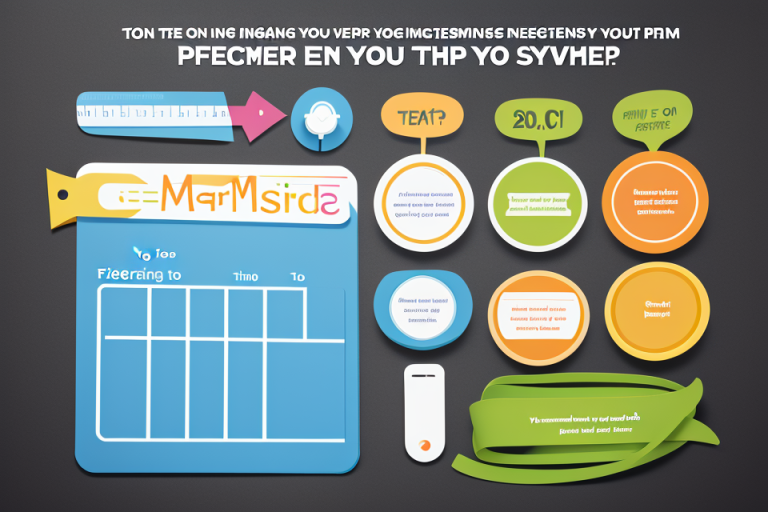What is the Right Size for Your Plate? A Guide to Healthy Portion Control
Ever wondered how much food you should be eating to maintain a healthy diet? The answer lies in understanding healthy portion sizes. Portion control is an essential aspect of maintaining a balanced diet, yet it’s often overlooked. In this guide, we’ll explore what healthy portion sizes look like for different types of food, and how to make sure you’re not over- or under-eating. Get ready to take control of your portion sizes and make the most out of your meals!
Understanding Portion Control
The Importance of Portion Control
Proper portion control is essential for maintaining a healthy diet and preventing overeating. It can help you manage your calorie intake, improve your nutrition, and prevent weight gain. Here are some reasons why portion control is so important:
- Reducing Overeating: Eating too much food at one time can lead to overeating, which can result in weight gain and other health problems. By controlling your portion sizes, you can avoid consuming excess calories and reduce your risk of obesity.
- Improving Nutrition: When you eat too much of a particular food, you may not be getting the nutrients your body needs. By controlling your portion sizes, you can ensure that you are getting the right amount of nutrients from each food group. This can help you maintain good health and prevent nutrient deficiencies.
- Maintaining a Healthy Weight: Maintaining a healthy weight is important for overall health and well-being. By controlling your portion sizes, you can avoid consuming too many calories and prevent weight gain. This can help you maintain a healthy weight and reduce your risk of obesity-related health problems.
Common Portion Sizes
When it comes to portion control, it’s important to understand the common portion sizes that are typically used in restaurants and households.
Serving Sizes vs. Portion Sizes
Serving sizes are standardized measurements of food that are used to determine the appropriate amount of food to be served or consumed. These sizes are typically based on the nutritional content of the food and are intended to provide a specific number of calories or grams of a particular nutrient.
Portion sizes, on the other hand, refer to the amount of food that is actually served or consumed. These sizes can vary greatly depending on factors such as individual preferences, cultural norms, and food availability.
Misleading Portion Sizes in Restaurants
Restaurant portion sizes can be misleading because they are often much larger than the recommended serving sizes. This can lead to overeating and consuming excess calories, which can contribute to weight gain and other health problems.
For example, a study conducted by the Journal of the Academy of Nutrition and Dietetics found that restaurant meals are often twice as large as the recommended serving size, with many meals containing over 1,000 calories.
Confusing Food Labels
Food labels can also be confusing when it comes to portion sizes. Many labels use terms such as “single serving” or “suggested serving size,” which can be misleading if the recommended serving size is much smaller than the actual portion size.
In addition, some labels use images of food to represent a serving size, which can be difficult to interpret. For example, a label may show a picture of a slice of bread, but it may not specify the size of the slice or how many slices constitute a serving.
Overall, understanding common portion sizes is an important step in practicing healthy portion control. By being aware of the recommended serving sizes for different foods, you can make informed choices about how much to eat and avoid consuming excess calories.
Healthy Portion Sizes for Different Food Groups
Fruits and Vegetables
Aim for Variety
Eating a wide variety of fruits and vegetables is important for a balanced diet. Each type of fruit and vegetable offers unique nutrients and health benefits. To get the most out of your diet, aim to include a variety of colors on your plate. This will ensure that you are consuming a wide range of vitamins, minerals, and antioxidants.
How Much is Enough?
The recommended daily servings of fruits and vegetables varies depending on age, gender, and activity level. For adults, it is recommended to consume at least 2.5 cups of fruits and 2.5 cups of vegetables per day. However, it’s important to note that these servings are just a guideline and may vary based on individual needs.
Tips for Incorporating More Fruits and Vegetables into Your Diet
- Start small: If you’re not used to eating a lot of fruits and vegetables, start by adding one or two servings a day and gradually increase your intake.
- Get creative: Experiment with different cooking methods, such as roasting, grilling, or sautéing, to make fruits and vegetables more interesting and enjoyable.
- Make it a habit: Incorporate fruits and vegetables into your meals and snacks at the same time each day. This will help make it a habit and make it easier to stick to.
- Be mindful of portion sizes: While it’s important to eat a variety of fruits and vegetables, it’s also important to be mindful of portion sizes. Overeating on any food, even healthy ones, can lead to weight gain and other health problems.
- Eat them raw: Eating fruits and vegetables raw is a great way to get the most nutrients and fiber. Try eating a piece of fruit as a snack or adding a salad or raw veggies to your meals.
Protein Sources
Protein is an essential macronutrient that plays a crucial role in many bodily functions. It is important to include an adequate amount of protein in your diet, but how much and from which sources? Here’s a guide to help you understand healthy portion sizes for different protein sources.
Meat, Poultry, and Seafood
- Beef: 3-4 ounces (about the size of a deck of cards)
- Pork: 2-3 ounces (about the size of a smartphone)
- Poultry: 3-4 ounces (about the size of a deck of cards)
- Seafood: 4-6 ounces (about the size of a tennis ball)
Dairy and Eggs
- Milk: 1 cup (about 8 ounces)
- Yogurt: 1 cup (about 6 ounces)
- Cheese: 1.5 ounces (about the size of a pair of dice)
- Eggs: 1 large egg (about 2 tablespoons)
Plant-Based Protein Sources
- Legumes (beans, lentils, peas): 1/2 cup cooked (about the size of a half-dollar coin)
- Nuts and seeds: 1/4 cup (about the size of a quarter)
- Tofu and tempeh: 1/2 block (about the size of a smartphone)
How Much Protein Should You Eat?
The Recommended Dietary Allowance (RDA) for protein varies depending on age, sex, and activity level. For most adults, the RDA is about 0.8 grams of protein per kilogram of body weight per day. However, athletes and people with physically demanding jobs may require more protein. It’s important to consult with a healthcare professional or registered dietitian to determine the appropriate amount of protein for your individual needs.
Grains and Carbohydrates
When it comes to grains and carbohydrates, it’s important to understand the difference between whole grains and refined grains. Whole grains contain all three parts of the grain – the bran, germ, and endosperm – which are rich in fiber, vitamins, and minerals. Refined grains, on the other hand, have been processed to remove the bran and germ, leaving behind mostly starch.
Whole grains are a healthy source of carbohydrates and should make up the majority of your grain intake. Some examples of whole grains include brown rice, quinoa, whole wheat pasta, and whole grain bread.
Refined grains, such as white rice, regular pasta, and white bread, are less nutritious and should be limited. However, they can still be a part of a healthy diet in moderation.
It’s also important to note that not all carbohydrates are created equal. Healthy carbohydrate sources include fruits, vegetables, legumes, and whole grains. These foods are rich in fiber, vitamins, and minerals, and are a key part of a healthy diet.
When it comes to portion sizes for grains and carbohydrates, the general recommendation is to fill half your plate with non-starchy vegetables, a quarter with whole grains, and a quarter with lean protein. For example, a serving of whole grain pasta is about 1/2 cup cooked, which is about the size of a tennis ball. A serving of brown rice is about 1/2 cup cooked, which is about the size of a small fist.
It’s also important to pay attention to portion sizes when it comes to other carbohydrate sources, such as fruit and starchy vegetables like potatoes and corn. A serving of fruit is about the size of a tennis ball, and a serving of starchy vegetables is about the size of a small fist.
In summary, when it comes to grains and carbohydrates, it’s important to choose whole grains and healthy carbohydrate sources, and to pay attention to portion sizes. Filling half your plate with non-starchy vegetables, a quarter with whole grains, and a quarter with lean protein can help ensure you’re getting a balanced diet.
Healthy Fats
The Importance of Healthy Fats
Healthy fats are an essential component of a balanced diet. They provide energy, support cell growth, and aid in the absorption of vitamins and minerals. Unsaturated fats, found in sources such as nuts, seeds, avocados, and olive oil, are considered healthy as they can lower LDL cholesterol levels and reduce the risk of heart disease. In contrast, saturated and trans fats, commonly found in processed foods and animal products, should be limited due to their potential to increase cholesterol levels and contribute to heart disease.
Portion Sizes for Healthy Fats
Adequate portion sizes of healthy fats can vary depending on individual caloric needs and overall dietary goals. A general guideline is to aim for a palm-sized portion of healthy fats, such as nuts or seeds, or a tablespoon-sized portion of oils, like olive or avocado oil, per meal. This amount can be adjusted based on personal preferences and energy needs.
Healthy Fat Sources
Healthy fat sources include:
- Nuts and seeds: Almonds, walnuts, flaxseeds, chia seeds, and pumpkin seeds are rich in healthy fats and offer a variety of essential nutrients.
- Avocados: A single avocado provides approximately 20 grams of healthy monounsaturated fats, making it an excellent addition to salads, sandwiches, or as a standalone snack.
- Olive oil: Extra virgin olive oil is a good source of heart-healthy monounsaturated fats and can be used in cooking, dressings, or as a dip.
- Plant-based oils: Oils such as canola, sunflower, and safflower oils are rich in healthy polyunsaturated fats and can be used for cooking or as a salad dressing.
- Fish: Fatty fish like salmon, mackerel, and sardines are high in omega-3 fatty acids, which support heart health and brain function. However, it is essential to choose low-mercury fish and consume them in moderation to minimize potential environmental contaminants.
By incorporating a variety of healthy fat sources into your diet, you can ensure that you are meeting your body’s needs for essential nutrients while maintaining a balanced and nutritious diet.
Portion Control Strategies
Mindful Eating
Paying Attention to Your Body’s Signals
One of the key components of mindful eating is paying attention to your body’s signals. This means listening to your hunger and fullness cues, rather than relying on external cues such as the time of day or the presence of food. By tuning in to your body’s signals, you can learn to recognize when you’re hungry or full, and adjust your food intake accordingly.
Eating Slowly and Savoring Your Food
Another important aspect of mindful eating is eating slowly and savoring your food. This means taking the time to really taste and enjoy your food, rather than rushing through meals or eating on the go. By slowing down and paying attention to your food, you can increase your enjoyment of meals and help prevent overeating.
Practicing Portion Control at Home
Practicing portion control at home is another key component of mindful eating. This means being mindful of the portion sizes you’re serving up, and using measuring cups or scales to ensure that you’re getting the right amount of food. By paying attention to portion sizes, you can help prevent overeating and ensure that you’re getting the nutrients you need.
Portion Control Tools
Measuring cups and scales are the most commonly used tools for portion control. They provide a precise measurement of the food you are serving, which can help you control your portion sizes. Using measuring cups and scales can be especially helpful when preparing foods that are easy to overeat, such as snack foods or treats.
Visual cues can also be useful for portion control. These can include things like portion control plates, which have sections or lines to guide you in serving the correct portion size. You can also use visual cues like a food scale to help you measure out the correct portion size.
Plate size and shape can also impact portion control. Using smaller plates can help you control your portion sizes, as you are less likely to overfill a smaller plate. You can also use larger plates for non-starchy vegetables, like leafy greens, and smaller plates for starchy vegetables, like sweet potatoes.
Overall, using portion control tools can be a helpful strategy for controlling your portion sizes and improving your overall health. By using measuring cups and scales, visual cues, and plate size and shape, you can more easily control your portion sizes and make healthier food choices.
Making Healthy Choices Easy
One of the most effective ways to practice healthy portion control is to make healthy choices easy. By removing temptations and making healthy options more accessible, you can simplify your journey towards healthier eating habits. Here are some strategies to help you make healthy choices easy:
Preparing Portions in Advance
Preparing portions in advance is an excellent way to ensure that you have healthy food options readily available when you need them. Here are some tips for preparing portions in advance:
- Plan your meals and snacks for the week: Spend some time at the beginning of the week to plan your meals and snacks. This will help you avoid last-minute decisions that may lead to unhealthy choices.
- Prepare meals and snacks in advance: Once you have planned your meals and snacks, prepare them in advance. This could include washing and chopping vegetables, cooking meals, or preparing snack containers.
- Store portions properly: Store portions properly to ensure that they stay fresh and nutritious. Use airtight containers or storage bags to keep food fresh and prevent spoilage.
Choosing Healthy Foods at Restaurants
Eating out can be challenging when it comes to healthy portion control. However, there are several strategies you can use to make healthy choices at restaurants:
- Choose dishes with whole grains: Look for dishes that are made with whole grains, such as brown rice, quinoa, or whole wheat pasta. These foods are more filling and provide more nutrients than refined grains.
- Order side dishes: Instead of ordering a large entree, consider ordering a side dish as your main meal. This can help you control your portion size and reduce your calorie intake.
- Share dishes: If you are dining with others, consider sharing dishes. This can help you reduce your portion size and save money.
Snacking Smart
Snacking can be a significant source of unhealthy calories, but it doesn’t have to be. Here are some tips for snacking smart:
- Choose nutrient-dense snacks: Opt for snacks that are high in nutrients and low in calories, such as fresh fruits and vegetables, raw nuts, or whole grain crackers.
- Control portion sizes: Even healthy snacks can become unhealthy if you eat too much of them. Use a measuring cup or a small bowl to control your portion sizes.
- Plan your snacks: Plan your snacks in advance to avoid mindless snacking. Keep healthy snacks on hand, such as cut-up fruits or vegetables, or a small bowl of nuts.
By making healthy choices easy, you can simplify your journey towards healthier eating habits. By preparing portions in advance, choosing healthy foods at restaurants, and snacking smart, you can make healthy choices more accessible and enjoyable.
Tips for Success
- Start Small and Gradual
- When it comes to making changes to your diet, it’s important to start small and gradually make adjustments. This approach can help you avoid feeling overwhelmed and discouraged, and it can also help you develop healthy habits that you can maintain over time.
- For example, if you’re used to eating large portions, you might start by reducing your portion size by 10% and gradually work your way down to a healthier portion size.
- Incorporate Portion Control into Your Daily Routine
- To make portion control a part of your daily routine, try incorporating it into your meal planning and preparation. This can help you ensure that you’re consistently eating the right-sized portions and can also help you save time and money by meal prepping.
- You can also try using smaller plates and bowls to help you visualize the right portion size.
- Stay Accountable with a Workout Buddy or Diet Buddy
- Having a workout buddy or diet buddy can be a great way to stay accountable and motivated on your health journey. This person can help you stay on track and provide support and encouragement when you need it.
- You can also try tracking your progress together, whether it’s through weight loss, body measurements, or other health metrics.
- Track Your Progress
- Tracking your progress can be a great way to stay motivated and see how far you’ve come. This can help you stay on track and can also help you identify areas where you might need to make adjustments to your diet or exercise routine.
- You can track your progress using a food diary, a fitness tracker, or a weight loss app. Just be sure to choose a method that works for you and that you’ll stick with over time.
The Bottom Line
Healthy portion control is achievable for everyone. By making mindful food choices and practicing portion control, you can improve your overall health and well-being. Prioritizing portion control can also lead to weight loss and a healthier lifestyle. However, it’s important to consult with a healthcare professional for personalized guidance on portion sizes that are appropriate for your individual needs and goals. With the right tools and support, you can successfully incorporate healthy portion control into your daily routine.
FAQs
1. What is a healthy portion size?
A healthy portion size is the amount of food that provides the appropriate amount of nutrients for your body without causing excessive calorie intake. The right portion size can vary depending on factors such as age, gender, activity level, and weight. Generally, a healthy portion size is about 75-100 grams of food per serving.
2. How can I determine appropriate portion sizes?
To determine appropriate portion sizes, it’s important to understand the serving sizes for different types of food. Serving sizes can vary depending on the food item, so it’s important to check the food label or the USDA’s Dietary Guidelines for the recommended serving sizes. For example, a serving of meat is about 3-4 ounces, while a serving of vegetables is about 1 cup.
3. What are some tips for controlling portion sizes?
There are several tips for controlling portion sizes:
* Use smaller plates and bowls to help you eat less.
* Eat slowly and savor your food to help you feel full.
* Avoid eating out of containers or bags, as it’s easy to overeat when food is accessible like this.
* Be mindful of your food choices and avoid distractions while eating, such as watching TV or using your phone.
* Practice portion control by measuring out your food or using a food scale to ensure you’re getting the right amount.
4. What are some healthy portion sizes for different foods?
Here are some examples of healthy portion sizes for different foods:
* Lean protein: 3-4 ounces, such as chicken, fish, or tofu
* Whole grains: 1/2 cup cooked, such as brown rice or quinoa
* Vegetables: 1 cup cooked, such as broccoli or carrots
* Fruits: 1 cup, such as berries or sliced fruit
* Dairy: 1 cup, such as yogurt or milk
Remember, portion sizes can vary depending on the food item, so it’s important to check the food label or the USDA’s Dietary Guidelines for the recommended serving sizes.







